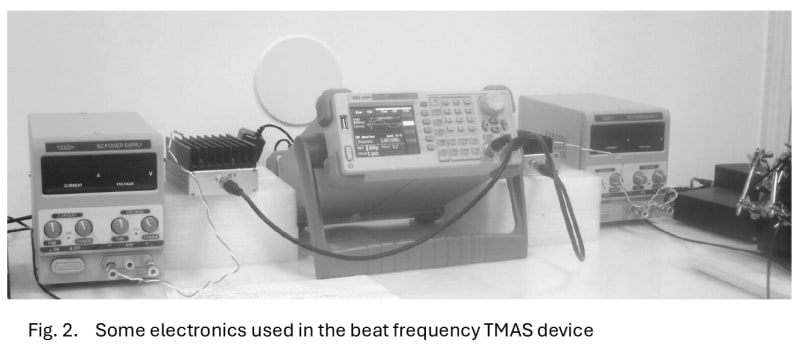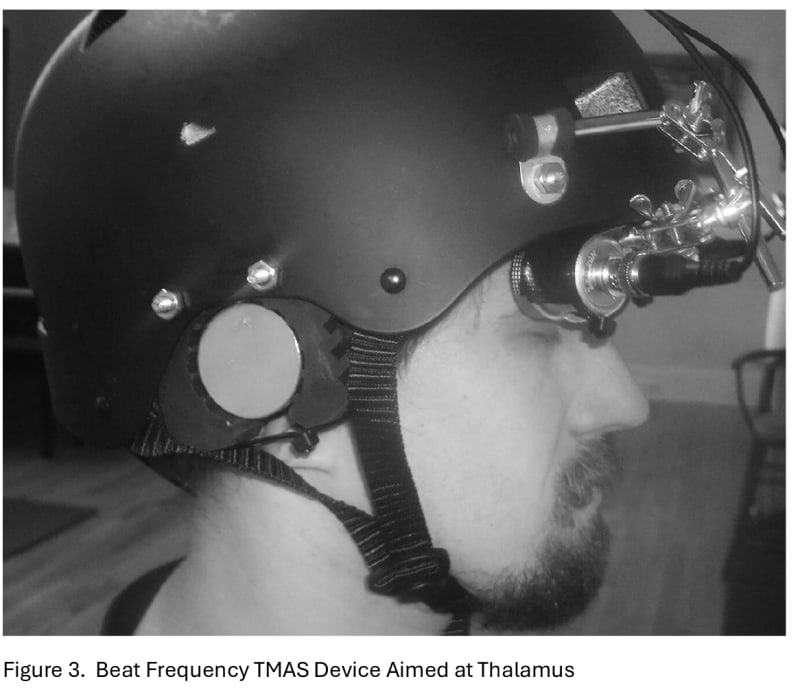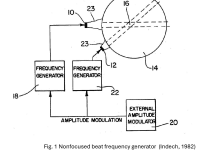Transcutaneous magneto acoustic stimulation is the application of an ultrasonic beam from outside the skull impinging on brain structures inside the skull, where a transverse magnetic field is externally applied. By using charged ion movement in a magnetic field, stimulation by electronic impulse (due to the magnetic field) is 500x more effective than mechanical nerve stimulation alone. Originally created by a Chinese research team, their process uses a single ultrasonic beam causing stimulation in the entire beam penetration field. Combining their technology with my 1982 ultrasonic patent, in which two ultrasonic sources of slightly differing frequency can be focally aimed at any small volume in brain tissue inside the skull and create mechanical stimulation at the modulated beat frequency of the two beams, allows precise noninvasive neural stimulation at any brain region.
Huber, in 2005, experimentally verified the principles shown in my 1982 patent through beat frequency stimulation of a reed some distance away from two near frequency ultrasonic sources.
The acoustic wave equation : ∇^2 P= 1/c^2 (∂^2 P)/(∂ t^2 ) , is solved for two independent pressure wave solutions, P1 and P2, which are combined at their intersection volume as:
P1 + P2 = 2 P0 e^(〖-aF〗_L ) (FL2/xC2) cos (π2f1(FL-ct)) cos (2πBF(FL-ct))
where a is the acoustic dampening constant, FL is the focal length, where xc is a small constant inserted to account for the inhomogeneity of the tissue density along the axis perpendicular to x, f1 is the base frequency, BF is the beat frequency, c is the speed of light, t is time.
A 5000-word paper is available upon request from the author at rindech@hotmail.com
The electronics needed to create the device include 2 channels of a precision frequency generator, an amplifier, an electronic impedance coupler to the ultrasonic probe, and a focused ultrasonic probe.
Both probes are placed in a stereotactic manipulator in a helmet for easy aiming at their interior skull intersection point.
Future manifestations may include many combinations of probes within the same helmet for multiple interior aiming points, may include an external sensor for a light image if the aiming points are in the visual cortex, may include an audio processing module for a frequency band to location adapter (similar to a human cochlea) if the aiming points are in the auditory cortex.
The magnet may be a fixed high intensity magnet (as shown in the test model) or an electromagnet of various types, depending on the magnetic strength and physical dimensions required.
Figure 1 shows the essentials of my patent. Figure 2 shows the electronics of the actual device. Figure 3 shows the helmet outfitted with a stereotactic manipulator for the ultrasonic probes.
Future developments include more in-vivo testing and development.
Like this entry?
-
About the Entrant
- Name:Robert Indech
- Type of entry:individual
- Patent status:pending









